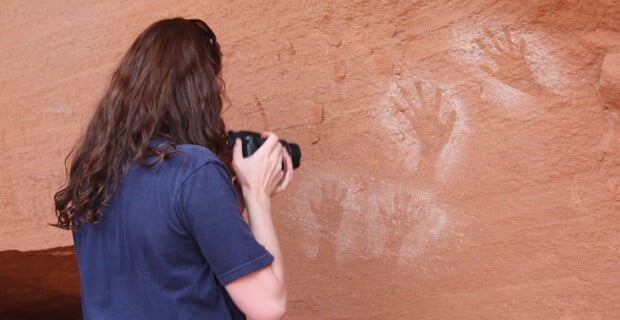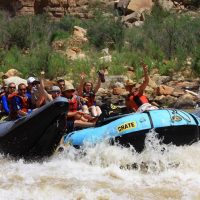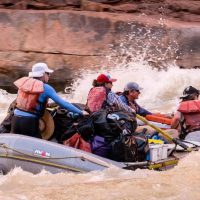Colorado River Rafting
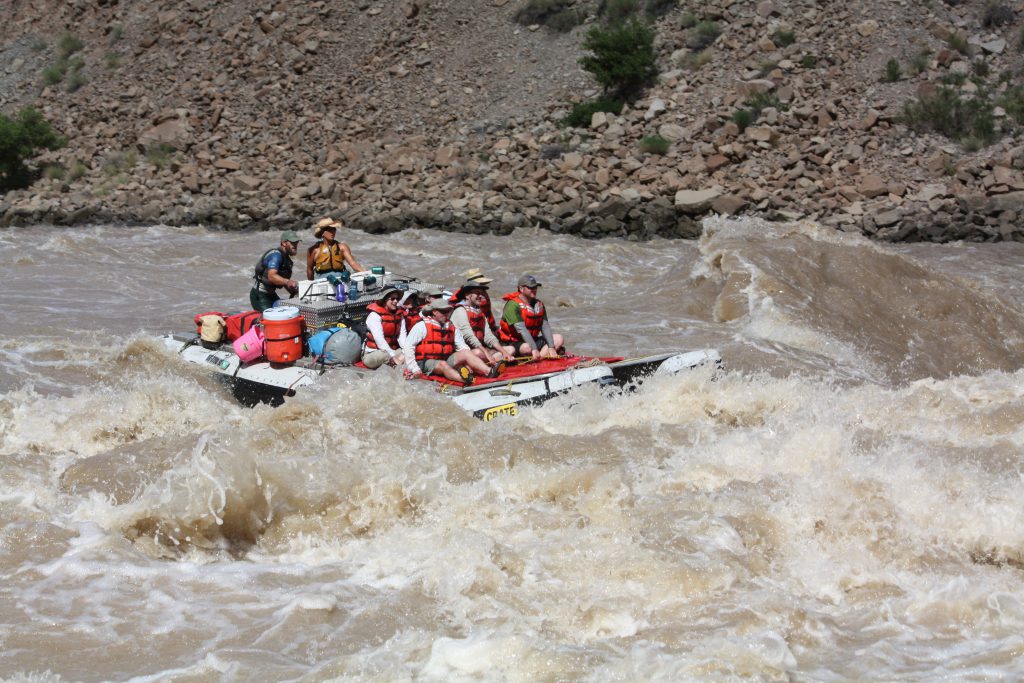
Our Top 3 Picks For Rafting the Colorado River
Why Choose CRATE?
- Under Original Ownership Since 1971
- 5 Star Rated Rafting Trips
- We Provide Everything You Need For a Great Rafting Trip
Book Your Adventure Today!
(800) 253-7328
Home » Rafting Down the River with CRATE » Colorado River Rafting
Colorado River Rafting
Slow Motion Ride Through Hermit Rapid, Colorado River, Grand Canyon
A Guide to the Best Colorado River Rafting Trips
Colorado River & Trail Expeditions operates rafting trips on the Colorado River in Utah and Arizona. From the Colorado/Utah border down to Lake Mead the river flows through some of the most amazing desert landscapes on Earth. These include Canyonlands National Park and Grand Canyon National Park.
The Colorado River is 1,450 miles in length and drains an area of 246,000 square miles. The River starts in the Rocky Mountains at La Poudre Pass. Before getting to The Colorado Plateau, the Colorado River flows down the Western Slope of the Rocky Mountains, through the Grand Valley, and finally through Ruby and Horsethief Canyons.
Rafting Westwater Canyon (River Mile 128-111)
Westwater Canyon 1-Day Rafting Trip
Westwater Canyon 2-Day Overnight Rafting Trip
Westwater Canyon 3-Day Colorado River Expedition
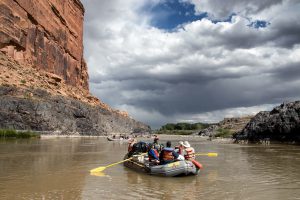
The Precambrian Rock walls grow taller heading downstream. At the Little Dolores River, there are some nice campsites and hiking opportunities. When the Little Dolores has water in it, there is a beautiful waterfall and swimming hole a short distance from the Colorado River. During drought years the Little Dolores completely dries up.
Just downstream from the Little Dolores there is a cave with a couple of old beds and a soot stained roof. Some people say the cave was used by brothers counterfeiting money. Others claim Butch Cassidy may have hid here while hiding out form the law. Whatever it was used for, the occupants left in a hurry, leaving behind tools, clothes, and artifacts. The area is very rugged and remote. When Bert Loper and Ellsworth Kolb first boated down the Colorado River through Westwater Canyon in 1916, very few non-native people had seen its beauty. It wasn’t until the 1950s the first 25 people had boated through Westwater Canyon.

Below the rapids the river slows down. This offers a nice opportunity to float in your lifejacket. In July and August, the Colorado River’s volume drops and the water warms. Big Horn camp is one of the most scenic and beautiful camps and has a nice sandy beach nestled in Precambrian metamorphic rock.
From Big Horn Camp to Cisco the canyon opens up. Bald Eagles are a common site along this part of the Colorado River. Cisco take-out was originally used as a pump station for the railroad.
Cisco to Fisher Towers (River Mile 111-88)

Fisher Towers Section of the Colorado River(River Mile 88-74)
1-Day Moab Rafting on the Colorado River

Colorado River Beyond The Daily Section To Potash (River Mile 74-47)
From the Daily Take-Out to Potash, the Colorado River continues its way toward its confluence with the Green River. It passes through the Moab Valley, along the Scott M. Matheson Wetlands Preserve, and into the Portal. The “Wall Street” sandstone cliffs along the Colorado River offer great opportunities for serious rock climbers.
Understanding the Colorado River Miles
The river miles above the Colorado River’s confluence with the Green River are measured in distance from the confluence. Below the confluence with the Green River the Colorado River’s mileage is measured as a distance from Lees Ferry. In the Grand Canyon the Colorado River’s mileage is measured as distance below Lees Ferry.
Cataract Canyon Rafting (River Mile 47-169 *Confluence is mile 0/216.5)
Cataract Canyon 4-Day Rafting Adventure
Cataract Canyon 6-day Rafting Expedition
When Major John Wesley Powell made his exploratory journey down the Green and Colorado Rivers in 1869, one of the main objectives of the expedition was to locate the confluence of the Green and the Grand Rivers, which was then thought to be the source of the Rio Colorado. The entire area was a huge blank on the maps of the day, and Powell and his men had no idea how far they would have to go, what obstacles they might encounter, or if indeed they would actually find such a juncture. As it turned out, on the 55th day of their journey down the Green River, they came to the confluence. Powell noted that they “eagerly rowed around into the Grand and set up camp on its banks.” They remained at this camp several days “for the purpose of determining the latitude and longitude, and the altitude of the walls.” Today this significant landmark is located in the center of Canyonlands National Park. We pass the confluence on every Cataract Canyon expedition and never fail to think of Powell and his small group of explorers who first mapped it and described it to the world.
If you are in the market for a good “all around” river adventure—one that will introduce you to the geology and prehistory of the canyon country; provide you with the opportunity to do a bit of nature study and a lot of hiking and exploring; and one that offers a “short, but sweet” dose of whitewater—–Cataract is the trip for you. We offer motorized expeditions in the spring and early summer, and then switch to rowing trips later on when the water levels are more suitable for the smaller rafts.
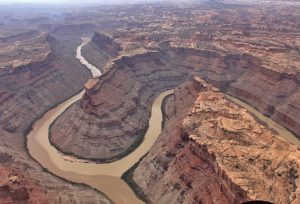
Below the confluence the sound of whitewater can be heard. The rapids come in quick succession. Currently there are approximately 30 rapids spanning 14 miles in Cataract Canyon. This number varies depending on the level of Lake Powell. Some of the rapids in Cataract Canyon have great names like Brown Betty, Mile Long, Capsize, Ben Hurt, Waterhole and the Big Drops. The Button, Red Wall, Little Niagara, The Claw, Satan’s Gut, Big Mossy, and Frog’s Hole are features found within these rapids. There are extreme water fluctuations on the Colorado River through Cataract Canyon. Flows vary from 3,000 cfs up to 100,000 cfs. During high flows the rapids of Cataract Canyon provide some of the biggest whitewater in North America. During lower flows the Colorado River through Cataract Canyon become rock strewn and technical.
On the last day of the Cataract Canyon trip, we once again travel on calm water. During these last few hours of the trip you will appreciate the chance to lie back, relax, and contemplate the many wonderful and marvelous things you have seen and done during your Canyonlands Odyssey.
Hite Marina to Glen Canyon Dam (River Mile 169-15)
This section of the Colorado River was the original Glen Canyon rafting trip. Today, this section of the Colorado River is covered by Lake Powell Reservoir. Some of the most beautiful canyons anywhere on the Colorado River were found in Glen Canyon. Today it is known as “The Place No One Knew” because very few people were lucky enough to experience its wonders.
“The chance to float quietly down a calm river, to let the current reveal a thousand years of history, the wild heritage that belonged in Glen, a canyon itself alive. Incredible, haunting beauty, where the creations of the Colorado rivaled any in the world, where the side canyons simply had no rivals. We lost wholeness, integrity, in a place no one knew well enough, in a place that might always have let people know how magnificent a gesture is the natural world”—–Phil Pennington and Chuck Washburn, from Glen Canyon, 1963.
Glen Canyon Dam to Lees Ferry (River Mile 15-0)
This 15 mile section of the Colorado River travels through the last part of Glen Canyon. Horseshoe Bend is found on this section of the Colorado River. Horseshoe Bend has become a very popular place to take photographs of the Colorado River meandering in a horseshoe pattern. The vantage point most photographs are taken from is from 1000 feet above the Colorado River. It is also possible to float around Horseshoe Bend.
Rafting the Grand Canyon of the Colorado River (River Mile 0-280)
8-Day Full Grand Canyon Rafting Expedition
7-Day Grand Canyon Rafting Expedition with Helicopter Take-Out at Whitmore Wash
3-Day Grand Canyon Ranch and Rafting Expedition from Las Vegas
4-Day Grand Canyon Ranch and Rafting Expedition from Las Vegas

For 280 miles, from Lee’s Ferry to Lake Mead, the Colorado River flows, churns, and gouges its way through the depths of the Grand Canyon. In places where debris has been washed into the river from side canyons rapids are created. These rapids range from riffles to major falls.
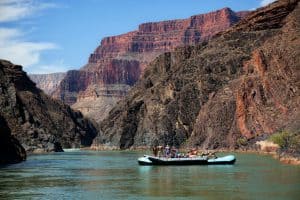
Daily off-river hiking excursions break up the time spent on the raft. There are dozens of side canyons with waterfalls and natural swimming pools where tropical monkey flowers grow within six feet of desert cactus. Some hikes lead to high plateaus where you are rewarded with a panoramic view of the Grand Canyon. Other hikes lead to historical or Ancestral Puebloan sites. Not every hike is destination oriented. Sometimes it’s nice to take a cross country walk to simply observe the flora and fauna.
Because of our commitment to off-river hiking in conjunction with every expedition, we know that our guests see places and do things that most other Grand Canyon travelers miss. You will come to know the Canyon “up close and personal,” in a way that few other people are entitled.
Below the Grand Canyon
The Colorado River flows into Lake Mead after Leaving Grand Canyon. Lake Mead is the largest reservoir by volume in the United States when it is full. Hoover Dam was the first dam put in on the Colorado River. It was built between 1931 and 1936.
Below Hoover Dam the Colorado flows through Black Canyon before being stopped by Davis Dam, then Parker Dam, Headgate Rock Dam, Palo Verde Dam, Imperial Dam, Laguna Dam, and Morelos Dam in Mexico. When there is water left in the river, it empties into the Sea of Cortez.
If you have any questions or to book an adventure today please call us at (800) 253-7328.
Grand Canyon River Rafting Recommendations
Spring Hiking & Rafting Special
The focus is on off-river hiking and exploration.
Our classic Grand Canyon rafting expedition. It offers ample time to see the sites and side canyons.
18-Foot rafts are rowed by guides. A paddle raft is available on a rotation basis.
Grand Canyon Rafting combined with a stay at the Bar 10 Ranch.
Home » Rafting Down the River with CRATE » Colorado River Rafting
CRATE Rafting Trips Since 1971
Free PDF copy of our Rafting Brochure!

